Myrtle rust host plants and symptoms

In Victoria myrtle rust (caused by the fungus Austropuccinia psidii) was never found in bushland or the natural environment.
The fungus was identified on 11 genera of Myrtaceae and up to 28 known species or plant varieties. The main Myrtaceae plants infected with myrtle rust were Lophomyrtus x ralphii varieties (especially 'Black Stallion') and Willow myrtle (Agonis flexuosa 'Nana').
These species have dense canopies and are frequently planted as hedges. Their compact growth may have created a microclimate for the fungus to establish and spread.
Some other genera infected with the fungus were:
- Austromyrtus
- Backhousia citriodora
- Callistemon (bottlebrush)
- Chamelaucium
- Metrosideros
- Myrtus
- Syzygium (lilly pilly, bush cherry and magenta cherry).
Only three Eucalyptus species (E. olida, E. polyanthemos and E. spectatrix) have been found with myrtle rust infections. Infections were mainly on leaves of potted plants and all these plants were destroyed.
Where myrtle rust comes from
The rust was first detected on common guava and lemon scented gum in South America but now is considered a native of South and Central America.
It was first found on the central coast of NSW in April 2010. Hosts infected were Agonis flexuosa 'After Dark', and later A. flexuosa cv 'Burgundy', Callistemon viminalis and Syncarpia glomulifera.
Symptoms of myrtle rust
Myrtle rust attacks young, soft, actively growing:
- leaves
- shoot tips
- stems
- fruits
- flowers.
The first sign of infection may be chlorotic spots on leaves and shoots, followed by the production of masses of egg-yolk yellow coloured spores. This will be about 14 days after infection, initially on the underside of the leaf but later on the upper leaf surface.
These lesions often turn red-purple then brown and might be surrounded by a purple margin. Lesions can extend through the leaf.
Old lesions are usually grey and may still contain a few spores
Severe rust disease in young trees can kill shoot tips, causing loss of leaders and a bushy habit.
Plants affected by myrtle rust
All members of the Myrtaceae plant family are potential hosts of myrtle rust, including:
- gum trees (Eucalyptus)
- bottlebrush (Callistemon, Melaleuca)
- tea tree (Leptospermum)
- lilly pilly (Syzygium, Acmena, Waterhousea)
- paperbark (Melaleuca)
- myrtle (Backhousia)
- guava (Psidium)
- midgen berry/midyim (Austromyrtus)
- scrub cherry, rose apple (Syzygium)
- brush box (Lophostemon)
- christmas bush (Metrosideros)
- lophomyrtus (Lophomyrtus)
- willow myrtle (Agonis)
- Geraldton wax (Chamelaucium)
How to recognise myrtle rust on common plants
Expand the following for images that show symptoms of myrtle rust infection on a range of Myrtaceae family plants.
Myrtle rust on strawberry gum (Eucalyptus olida):
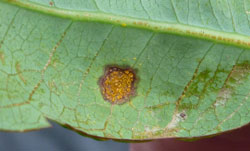

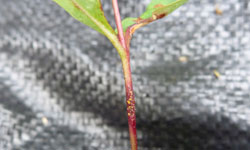
Myrtle rust on red box (Eucalyptus polyanthemos):
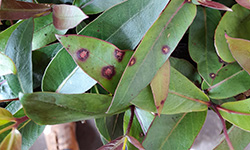
Myrtle rust on bottlebrush (Callistemon):


Callistemon 'Harkness' bottlebrush infested with myrtle rust:
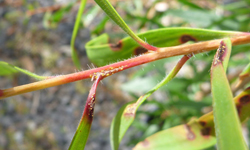

Geraldton wax (Chamelaucium uncinatum) infested with myrtle rust:


Myrtle rust symptoms on Fiji Christmas bush (Metrosideros collina):

Myrtle rust spores on lemon-scented myrtle (Backhousia citriodora):
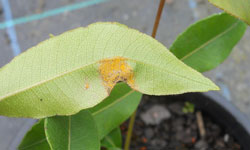

Common myrtle (Myrtus communis) affected by myrtle rust:
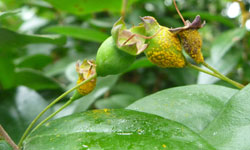

Myrtle rust spores on lophomyrtus 'Black Stallion':


Myrtle rust spores on Acmena lilly pilly:
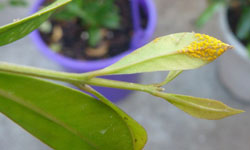
Myrtle rust symptoms on Syzygium lilly pilly:
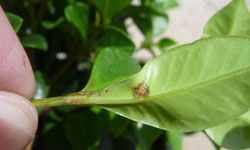

Myrtle rust spores on Agonis flexuosa 'After Dark':

Myrtle rust on willow myrtle (Agonis flexuosa) (photo courtesy Dr Angus Carnegie © I&I NSW):
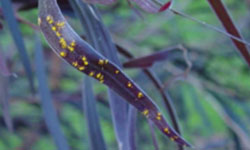
Newly formed bright yellow myrtle rust spores on turpentine (Syncarpia glomulifera) (photo courtesy NSW I&I):

Older myrtle rust infection on turpentine (Syncarpia glomulifera) (photo courtesy of NSW I&I). Note that older lesions can be dull yellow or brown to ash in colour and spore masses may have disappeared:

Yellow myrtle rust spores appearing on the fruit of beach cherry (Eugenia reinwardtiana) (photo courtesy of Queensland Department of Employment, Economic Development and Innovation):
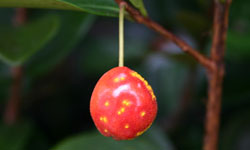
Yellow myrtle rust spores appearing on the immature fruit and flower of iron malletwood (Rhodamnia sessiliflora) (photo courtesy of Queensland Department of Employment, Economic Development and Innovation):

Myrtle rust spores on mountain ash (Eucalyptus regnans) inoculated under controlled conditions (photo courtesy of Dr Louise Morin, CSIRO Ecosystem Sciences):
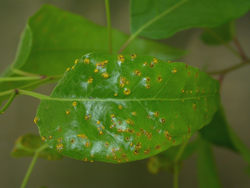
Image credits
Willow myrtle (Agonis flexuosa) photo courtesy Dr Angus Carnegie © I&I NSW, and all other images courtesy David Smith, Agriculture Victoria.